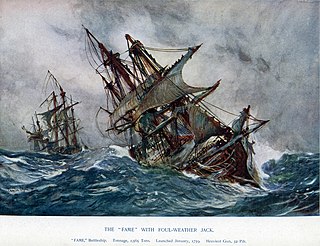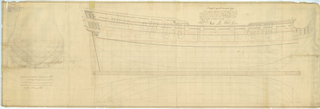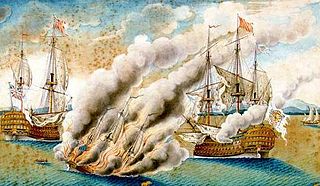
HMS Royal Oak was a 74-gun third-rate ship of the line of the Royal Navy, built by Jonas Shish at Deptford and launched in 1674. She was one of only three Royal Navy ships to be equipped with the Rupertinoe naval gun. Life aboard her when cruising in the Mediterranean Sea in 1679 is described in the diary of Henry Teonge.

HMS Fame was a 74-gun third-rate ship of the line of the Royal Navy, in service during the Seven Years' War and the American Revolutionary War.

HMS Northumberland was a 70-gun third rate ship of the line of the Royal Navy, built at Plymouth Dockyard to the draught specified by the 1745 Establishment, and launched on 1 December 1750.

HMS Illustrious was a 74-gun third rate ship of the line of the Royal Navy, launched on 7 July 1789 at Bucklers Hard under the direction of Henry Adams. She participated in the Battle of Genoa after which she was wrecked.

HMS Cambridge was an 80-gun third-rate ship of the line of the Royal Navy, designed by Sir Joseph Allin and built at Deptford Dockyard by Adam Hayes to the draught specified by the 1745 Establishment as amended in 1750, and launched on 21 October 1755.

HMS Hero was a 74-gun third rate of the Royal Navy, launched on 18 August 1803 at Blackwall Yard.
HMS Greenwich was a 54-gun fourth-rate ship of the line of the Royal Navy, built by Christopher Pett at Woolwich Dockyard and launched in 1666.

HMS St Michael was a 90-gun second rate ship of the line of the Royal Navy, built by John Tippetts of Portsmouth Dockyard and launched in 1669.
HMS Defiance was a 64-gun third rate ship of the line of the Royal Navy, built by Phineas Pett II at Chatham Dockyard, and launched in 1675.

HMS Oxford was a 54-gun fourth-rate ship of the line of the Royal Navy, built by Francis Baylie in Bristol and launched in June 1674. Her guns comprised twenty-two 24-pounders on the lower deck, with twenty-two large sakers (8-pounders) on the upper deck and ten smaller sakers (5-pounders) on the quarterdeck.

HMS Orford was a 70-gun third-rate ship of the line of the Royal Navy, launched at Deptford in 1698. She carried twenty-two 24-pounder guns and four (18-pounder) culverins on the lower deck; twenty-six 12-pounder guns on the upper deck; fourteen (5-pounder) sakers on the quarterdeck and forecastle; and four 3-pounder guns on the poop or roundhouse.

HMS Namur was a 90-gun second rate ship of the line of the Royal Navy, launched at Woolwich Dockyard in 1697.
HMS Triumph was a 90-gun second rate ship of the line of the Royal Navy, launched at Chatham Dockyard on 2 March 1697. She was renamed HMS Prince in 1714.

HMS Lion or Lyon was a 60-gun fourth rate ship of the line of the Royal Navy, built at Chatham Dockyard to the 1706 Establishment and launched on 20 January 1709.
HMS Tilbury was a 60-gun fourth-rate ship of the line of the Royal Navy, built at Chatham Dockyard to the dimensions of the 1719 Establishment, and launched on 2 June 1733.

HMS Stirling Castle was a 70-gun third rate ship of the line of the Royal Navy, built at Chatham Dockyard to the 1733 proposals of the 1719 Establishment, and launched on 24 April 1742.

HMS Colchester was a 50-gun fourth rate ship of the line of the Royal Navy, built at King's Yard in Harwich by John Barnard according to the dimensions specified in the 1741 proposals of the 1719 Establishment, and launched on 14 August 1744.

HMS Ruby was a 50-gun fourth rate ship of the line of the Royal Navy, built at Bursledon in Hampshire to the dimensions specified in the 1741 proposals of the 1719 Establishment, and launched on 3 August 1745.

HMS Colchester was a 50-gun fourth rate ship of the line of the Royal Navy, built at Southampton according to the dimensions laid down in the 1741 proposals of the 1719 Establishment, and launched on 20 September 1745. She was ordered as a replacement for the previous HMS Colchester, which had been wrecked just two months after being launched.

HMS Dunkirk was a 60-gun fourth-rate ship of the line of the Royal Navy, built by Edward Allin at Woolwich Dockyard to the draught specified by the 1745 Establishment as amended in 1750, and launched on 22 July 1754.














